Abstract
The physiological role of thyrotropin-releasing hormone (TRH) in the regulation of thyrotropin (thyroid-stimulating hormone, TSH) and prolactin (Prl) secretion has been assumed but not proven. Stimulation of their release requires pharmacologic doses of TRH. Lesions of the hypothalamus usually induce an inhibition of TSH secretion and an increase in Prl. To determine whether TRH is essential for TSH and Prl secretion in the rat, 0.1 ml of TRH antiserum (TRH-Ab) or normal rabbit serum was administered to normal, thyroidectomized, cold-exposed, and proestrus rats through indwelling atrial catheter. Serum samples were obtained before and at frequent intervals thereafter. Serum TSH concentrations in normal, thyroidectomized, cold-exposed, and proestrus rats were not depressed in specimens obtained up to 24 h after injection of normal rabbit serum. In contrast, serum TSH was significantly decreased after the administration of TRH-Ab in all normal (basal, 41±8 μU/ml [mean±SE]; 30 min, 6±2; 45 min, 8±3; 75 min, 4±2); thyroidectomized (basal, 642±32 μU/ml; 30 min, 418±32; 60 min, 426±36; 120 min, 516±146); coldstressed (basal, 68±19 μU/ml; 30 min, 4±3; 180 min, 16±8); and proestrus (basal, 11 a.m., 57±10 μU/ml; 1 p.m., 20±3; 3 p.m., 13±4; 5 p.m., 19±3) rats. However, 0.1 ml of TRH-Ab had no effect on basal Prl concentrations in normal or thyroidectomized rats and did not prevent the Prl rise in rats exposed to cold (basal, 68±7 ng/ml; 15 min, 387±121; 30 min, 212±132; 60 min, 154±114), or the Prl surge observed on the afternoon of proestrus (basal 11 a.m., 23±2 ng/ml; 1 p.m., 189±55; 3 p.m., 1,490±260; 5 p.m., 1,570±286). These studies demonstrate that TRH is required for TSH secretion in the normal, cold-exposed and proestrus rat and contributes, at least in part, to TSH secretion in the hypothyroid rat, but is not required for Prl secretion in these states.
Full text
PDF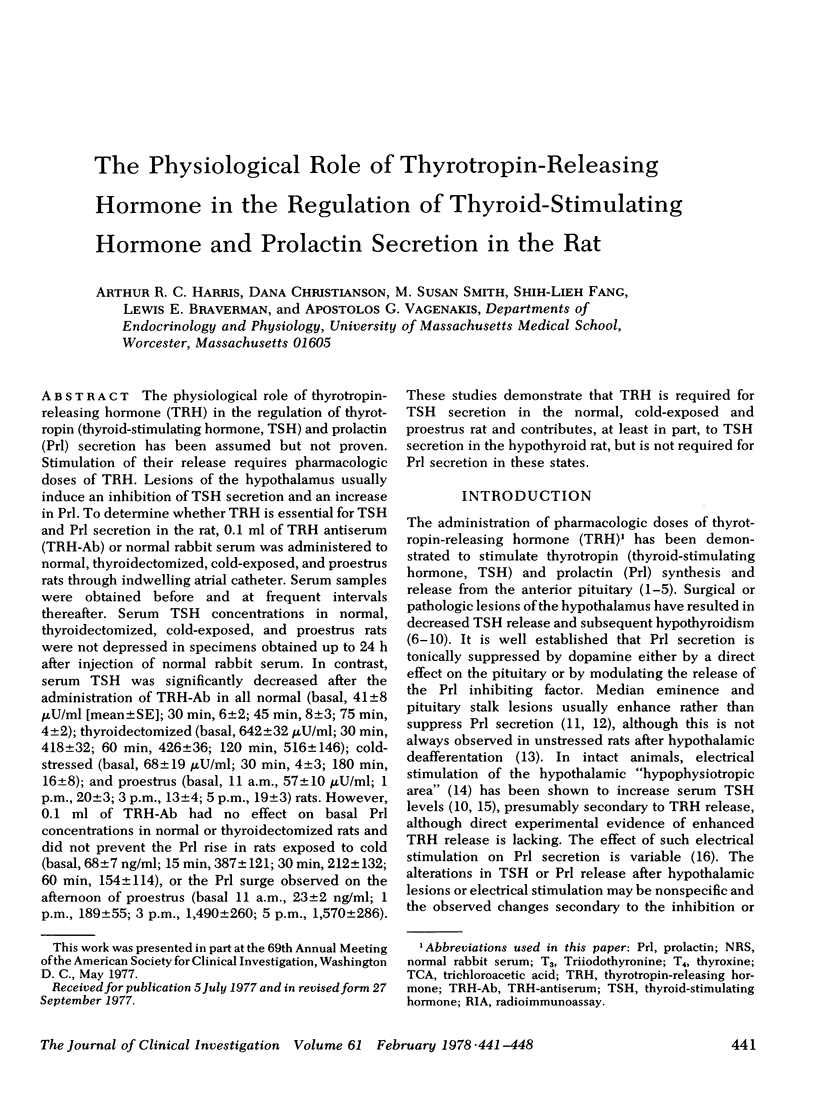
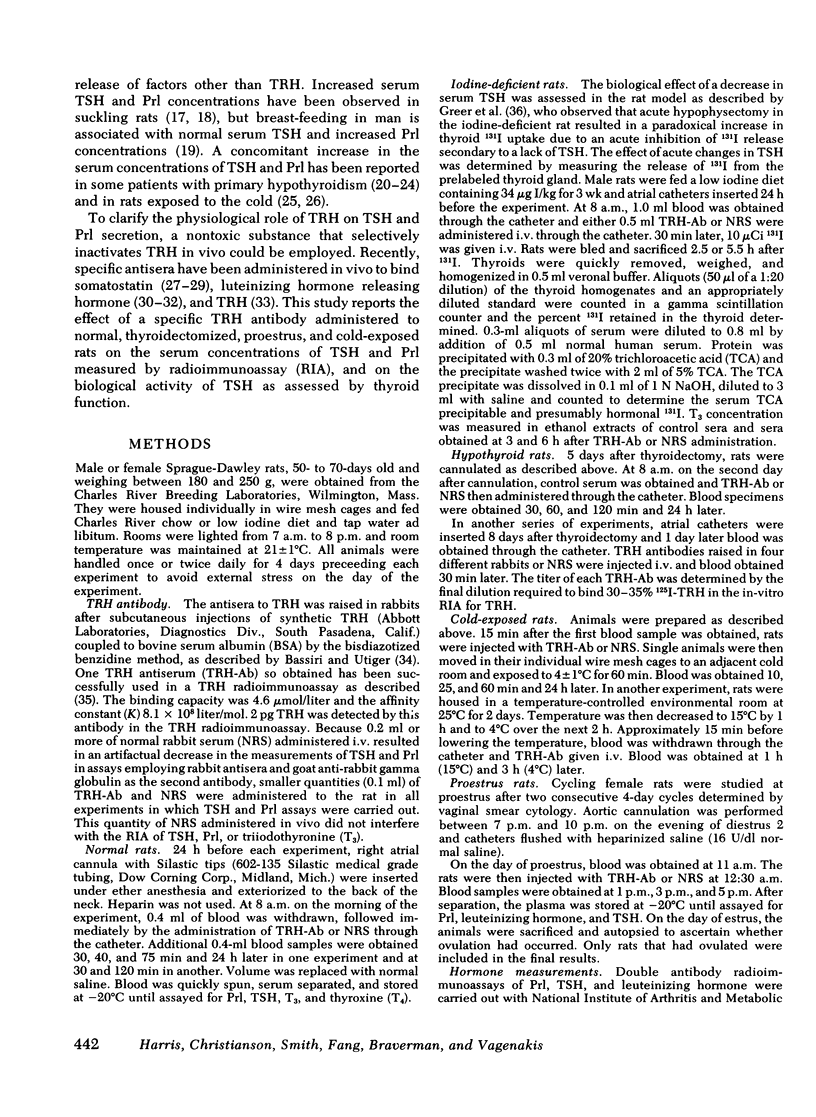
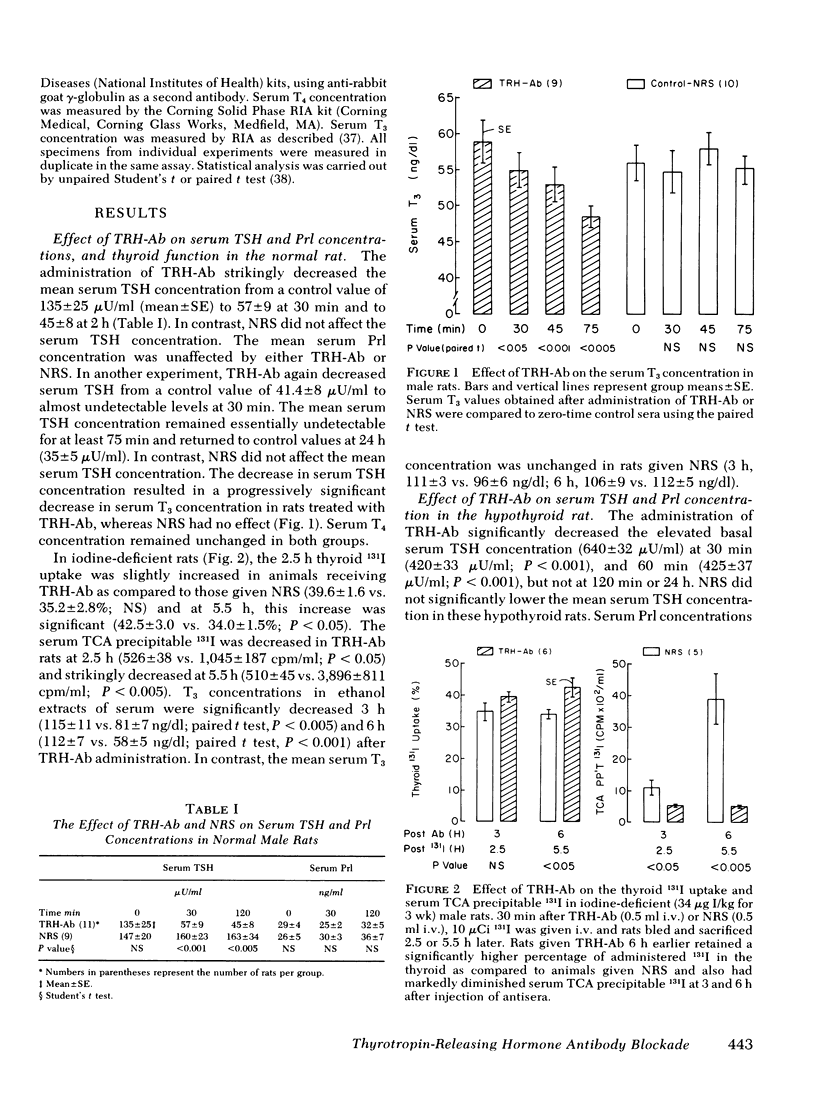
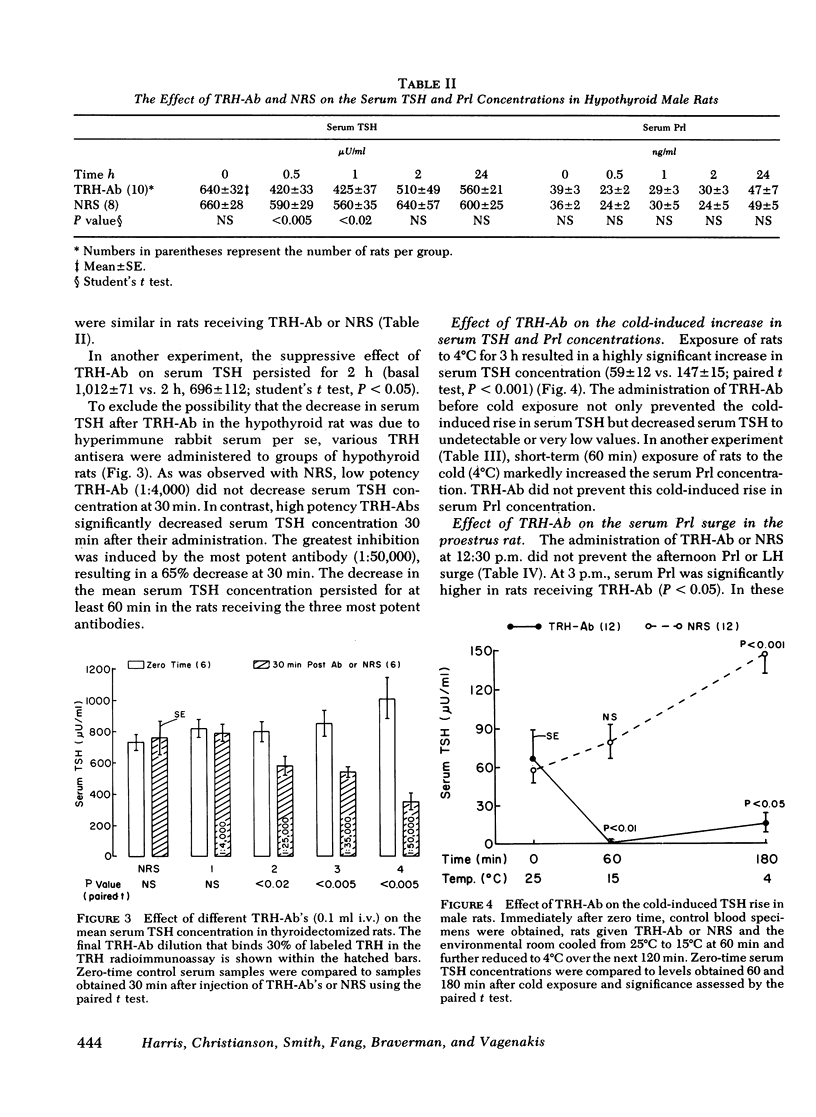
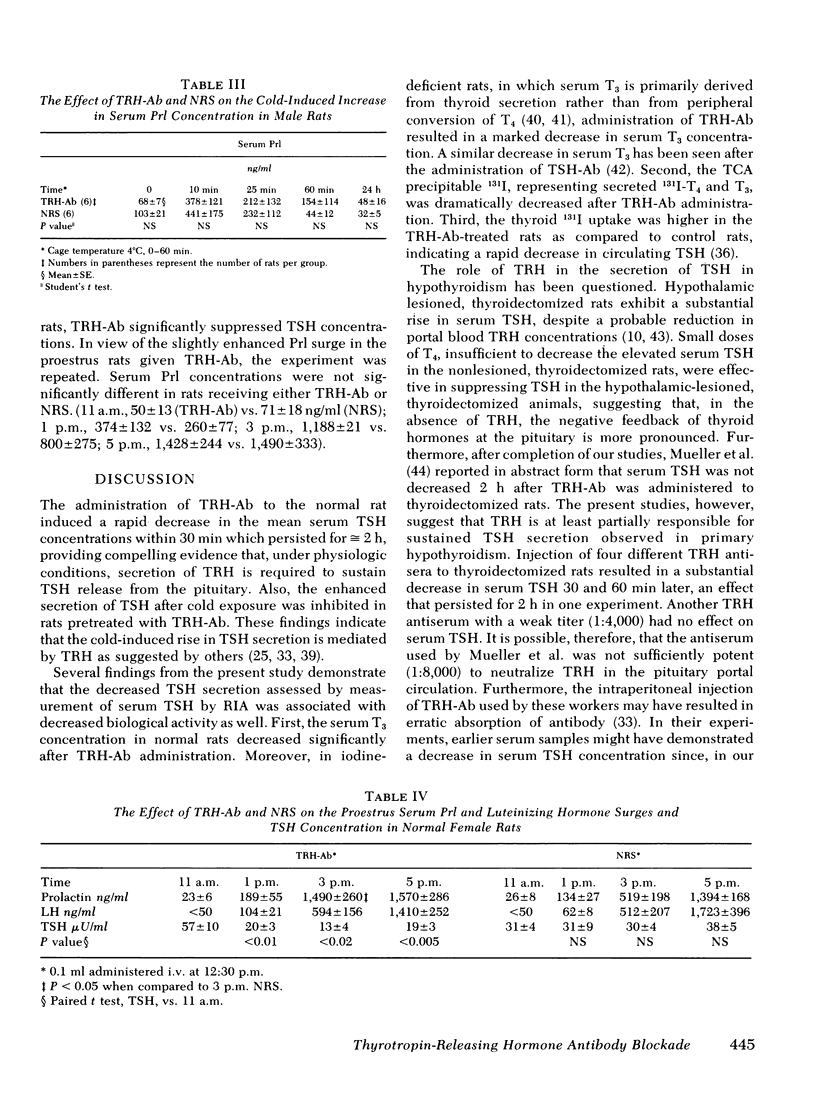
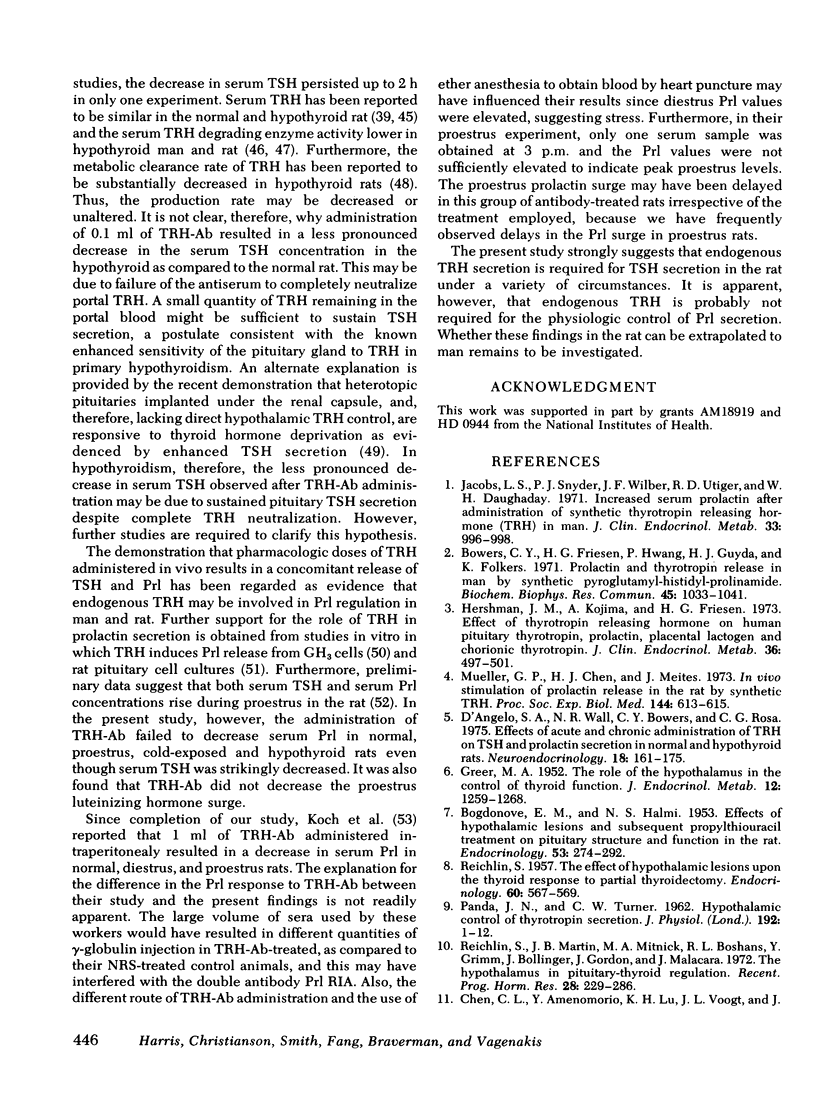
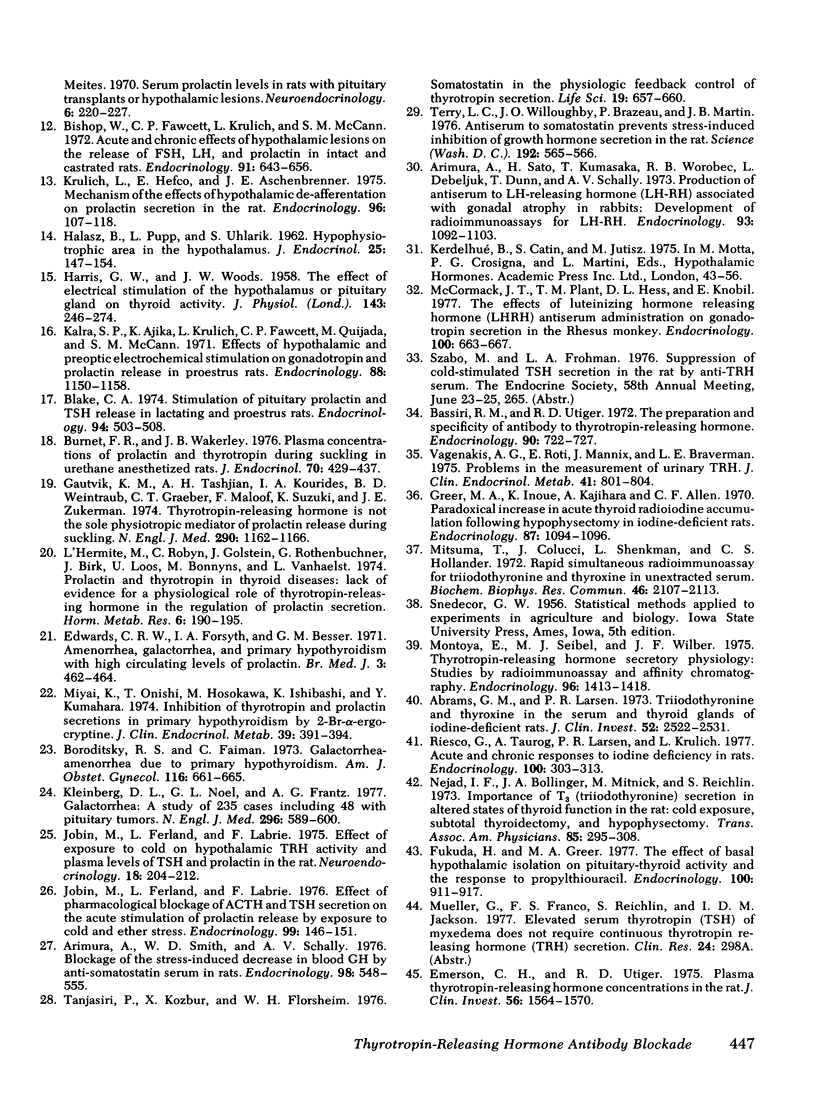
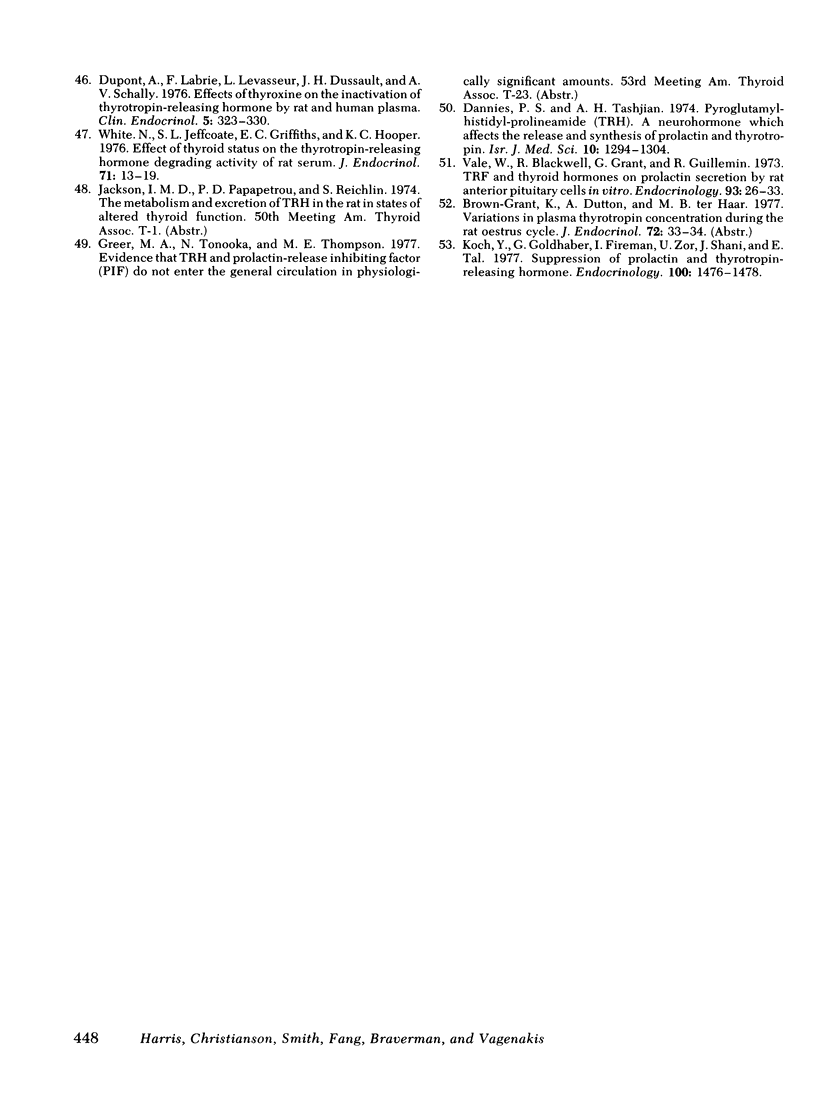
Selected References
These references are in PubMed. This may not be the complete list of references from this article.
- Abrams G. M., Larsen P. R. Triiodothyronine and thyroxine in the serum and thyroid glands of iodine-deficient rats. J Clin Invest. 1973 Oct;52(10):2522–2531. doi: 10.1172/JCI107443. [DOI] [PMC free article] [PubMed] [Google Scholar]
- Arimura A., Sato H., Kumasaka T., Worobec R. B., Debeljuk L., Dunn J., Schally A. V. Production of antiserum to LH-releasing hormone (LH-RH) associated with gonadal atrophy in rabbits: development of radioimmunoassays for LH-RH. Endocrinology. 1973 Nov;93(5):1092–1103. doi: 10.1210/endo-93-5-1092. [DOI] [PubMed] [Google Scholar]
- BOGDANOVE E. M., HALMI N. S. Effects of hypothalamic lesions and subsequent propylthiouracil treatment on pituitary structure and function in the rat. Endocrinology. 1953 Sep;53(3):274–292. doi: 10.1210/endo-53-3-274. [DOI] [PubMed] [Google Scholar]
- Bassiri R. M., Utiger R. D. The preparation and specificity of antibody to thyrotropin releasing hormone. Endocrinology. 1972 Mar;90(3):722–727. doi: 10.1210/endo-90-3-722. [DOI] [PubMed] [Google Scholar]
- Bishop W., Fawcett C. P., Krulich L., McCann S. M. Acute and chronic effects of hypothalamic lesions on the release of FSH, LH and prolactin in intact and castrated rats. Endocrinology. 1972 Sep;91(3):643–656. doi: 10.1210/endo-91-3-643. [DOI] [PubMed] [Google Scholar]
- Blake C. A. Stimulation of pituitary prolactin and TSH release in lactating and proestrous rats. Endocrinology. 1974 Feb;94(2):503–508. doi: 10.1210/endo-94-2-503. [DOI] [PubMed] [Google Scholar]
- Boroditsky R. S., Faiman C. Galactorrhea-amenorrhea due to primary hypothyroidism. Am J Obstet Gynecol. 1973 Jul 1;116(5):661–665. doi: 10.1016/s0002-9378(15)33131-8. [DOI] [PubMed] [Google Scholar]
- Bowers C. Y., Friesen H. G., Hwang P., Guyda H. J., Folkers K. Prolactin and thyrotropin release in man by synthetic pyroglutamyl-histidyl-prolinamide. Biochem Biophys Res Commun. 1971 Nov;45(4):1033–1041. doi: 10.1016/0006-291x(71)90441-4. [DOI] [PubMed] [Google Scholar]
- Burnet F. R., Wakerley J. B. Plasma concentrations of prolactin and thyrotrophin during suckling in urethane-anaesthetized rats. J Endocrinol. 1976 Sep;70(3):429–437. doi: 10.1677/joe.0.0700429. [DOI] [PubMed] [Google Scholar]
- Chen C. L., Amenomori Y., Lu K. H., Voogt J. L., Meites J. Serum prolactin levels in rats with pituitary transplants or hypothalamic lesions. Neuroendocrinology. 1970;6(4):220–227. doi: 10.1159/000121946. [DOI] [PubMed] [Google Scholar]
- D'Angelo S. A., Wall N. R., Bowers C. Y., Rosa C. G. Effects of acute and chronic administration of TRH on TSH and prolactin secretion in normal and hypothyroid rats. Neuroendocrinology. 1975;18(2):161–175. doi: 10.1159/000122396. [DOI] [PubMed] [Google Scholar]
- Dannies P. S., Tashjian A. H., Jr Pyroglutamyl-histidyl-prolineamide (TRH). A neurohormone which affects the release and synthesis of prolactin and thyrotropin. Isr J Med Sci. 1974 Oct;10(10):1294–1304. [PubMed] [Google Scholar]
- Dupont A., Labrie F., Levasseur L., Dussault J. H., Schally A. V. Effect of thyroxine on the inactivation of thyrotrophin-releasing hormone by rat and human plasma. Clin Endocrinol (Oxf) 1976 Jul;5(4):323–330. doi: 10.1111/j.1365-2265.1976.tb01961.x. [DOI] [PubMed] [Google Scholar]
- Edwards C. R., Forsyth I. A., Besser G. M. Amenorrhoea, galactorrhoea, and primary hypothyroidism with high circulating levels of prolactin. Br Med J. 1971 Aug;3(5772):462–464. doi: 10.1136/bmj.3.5772.462. [DOI] [PMC free article] [PubMed] [Google Scholar]
- Emerson C. H., Utiger R. D. Plasma thyrotropin-releasing hormone concentrations in the rat. Effect of thyroid excess and deficiency and cold exposure. J Clin Invest. 1975 Dec;56(6):1564–1570. doi: 10.1172/JCI108238. [DOI] [PMC free article] [PubMed] [Google Scholar]
- Fukuda H., Greer M. A. The effect of basal hypothalamic isolation on pituitary-thyroid activity and the response to propylthiouracil. Endocrinology. 1977 Apr;100(4):911–917. doi: 10.1210/endo-100-4-911. [DOI] [PubMed] [Google Scholar]
- GREER M. A. The role of the hypothalamus in the control of thyroid function. J Clin Endocrinol Metab. 1952 Oct;12(10):1259–1268. doi: 10.1210/jcem-12-10-1259. [DOI] [PubMed] [Google Scholar]
- Gautvik K. M., Tashjian A. H., Jr, Kourides I. A., Weintraub B. D., Graeber C. T., Maloof F., Suzuki K., Zuckerman J. E. Thyrotropin-releasing hormone is not the sole physiologic mediator of prolactin release during suckling. N Engl J Med. 1974 May 23;290(21):1162–1165. doi: 10.1056/NEJM197405232902103. [DOI] [PubMed] [Google Scholar]
- Greer M. A., Inoue K., Kajihara A., Allen C. F. Paradoxical increase in acute thyroid radioiodine accumulation following hypophysectomy in iodine-deficient rats. Endocrinology. 1970 Nov;87(5):1094–1096. doi: 10.1210/endo-87-5-1094. [DOI] [PubMed] [Google Scholar]
- HALASZ B., PUPP L., UHLARIK S. Hypophysiotrophic area in the hypothalamus. J Endocrinol. 1962 Oct;25:147–154. doi: 10.1677/joe.0.0250147. [DOI] [PubMed] [Google Scholar]
- HARRIS G. W., WOODS J. W. The effect of electrical stimulation of the hypothalamus or pituitary gland on thyroid activity. J Physiol. 1958 Sep 23;143(2):246–274. doi: 10.1113/jphysiol.1958.sp006057. [DOI] [PMC free article] [PubMed] [Google Scholar]
- Hershman J. M., Kojima A., Friesen H. G. Effect of thyrotropin-releasing hormone on human pituitary thyrotropin, prolactin, placental lactogen, and chorionic thyrotropin. J Clin Endocrinol Metab. 1973 Mar;36(3):497–501. doi: 10.1210/jcem-36-3-497. [DOI] [PubMed] [Google Scholar]
- Jacobs L. S., Snyder P. J., Wilber J. F., Utiger R. D., Daughaday W. H. Increased serum prolactin after administration of synthetic thyrotropin releasing hormone (TRH) in man. J Clin Endocrinol Metab. 1971 Dec;33(6):996–998. doi: 10.1210/jcem-33-6-996. [DOI] [PubMed] [Google Scholar]
- Jobin M., Ferland L., Côté J., Labrie F. Effect of exposure to cold on hypothalamic TRH activity and plasma levels of TSH and prolactin in the rat. Neuroendocrinology. 1975;18(2):204–212. doi: 10.1159/000122399. [DOI] [PubMed] [Google Scholar]
- Jobin M., Ferland L., Labrie F. Effect of pharmacological blockade of ACTH and TSH secretion on the acute stimulation of prolactin release by exposure to cold and ether stress. Endocrinology. 1976 Jul;99(1):146–151. doi: 10.1210/endo-99-1-146. [DOI] [PubMed] [Google Scholar]
- Kalra S. P., Ajika K., Krulich L., Fawcett C. P., Quijada M., McCann S. M. Effects of hypothalamic and preoptic electrochemical stimulation on gonadotropin and prolactin release in proestrous rats. Endocrinology. 1971 May;88(5):1150–1158. doi: 10.1210/endo-88-5-1150. [DOI] [PubMed] [Google Scholar]
- Kleinberg D. L., Noel G. L., Frantz A. G. Galactorrhea: a study of 235 cases, including 48 with pituitary tumors. N Engl J Med. 1977 Mar 17;296(11):589–600. doi: 10.1056/NEJM197703172961103. [DOI] [PubMed] [Google Scholar]
- Koch Y., Goldhaber G., Fireman I., Zor U., Shani J., Tal E. Suppression of prolactin and thyrotropin secretion in the rat by antiserum to thyrotropin-releasing hormone. Endocrinology. 1977 May;100(5):1476–1478. doi: 10.1210/endo-100-5-1476. [DOI] [PubMed] [Google Scholar]
- Krulich L., Hefco E., Aschenbrenner J. E. Mechanism of the effects of hypothalamic deafferentation on prolactin secretion in the rat. Endocrinology. 1975 Jan;96(1):107–118. doi: 10.1210/endo-96-1-107. [DOI] [PubMed] [Google Scholar]
- L'Hermite M., Robyn C., Golstein J., Rothenbuchner G., Birk J., Loos U., Bonnyns M., Vanhaelst L. Prolactin and thyrotropin in thyroid diseases: lack of evidence for a physiological role of thyrotropin-releasing hormone in the regulation of prolactin secretion. Horm Metab Res. 1974 May;6(3):190–195. doi: 10.1055/s-0028-1093871. [DOI] [PubMed] [Google Scholar]
- McCormack J. T., Plant T. M., Hess D. L., Knobil E. The effect of luteinizing hormone releasing hormone (LHRH) antiserum administration on gonadotropin secretion in the rhesus monkey. Endocrinology. 1977 Mar;100(3):663–667. doi: 10.1210/endo-100-3-663. [DOI] [PubMed] [Google Scholar]
- Mitsuma T., Colucci J., Shenkman L., Hollander C. S. Rapid simultaneous radioimmunoassay for triiodothyronine and thyroxine in unextracted serum. Biochem Biophys Res Commun. 1972 Mar 24;46(6):2107–2113. doi: 10.1016/0006-291x(72)90766-8. [DOI] [PubMed] [Google Scholar]
- Miyal K., Onishi T., Hosokawa M., Ishibashi K., Kumahara Y. Inhibition of thyrotropin and prolactin secretions in primary hypothyroidism by 2-Br-alpha-ergocryptine. J Clin Endocrinol Metab. 1974 Aug;39(2):391–394. doi: 10.1210/jcem-39-2-391. [DOI] [PubMed] [Google Scholar]
- Montoya E., Seibel M. J., Wilber J. F. Thyrotropin-releasing hormone secretory physiology: studies by radioimmunoassay and affinity chromatography. Endocrinology. 1975 Jun;96(6):1413–1418. doi: 10.1210/endo-96-6-1413. [DOI] [PubMed] [Google Scholar]
- Mueller G. P., Chen H. J., Meites J. In vivo stimulation of prolactin release in the rat by synthetic TRH. Proc Soc Exp Biol Med. 1973 Nov;144(2):613–615. doi: 10.3181/00379727-144-37645. [DOI] [PubMed] [Google Scholar]
- Nejad I. F., Bollinger J. A., Mitnick M., Reichlin S. Importance of T 3 (triiodothyronine) secretion in altered states of thyroid function in the rat: cold exposure, subtotal thyroidectomy, and hypophysectomy. Trans Assoc Am Physicians. 1972;85:295–308. [PubMed] [Google Scholar]
- Panda J. N., Turner C. W. Hypothalamic control of thyrotrophin secretion. J Physiol. 1967 Sep;192(1):1–12. doi: 10.1113/jphysiol.1967.sp008283. [DOI] [PMC free article] [PubMed] [Google Scholar]
- REICHLIN S. The effect of hypothalamic lesions upon the thyroid response to partial thyroidectomy. Endocrinology. 1957 Apr;60(4):567–569. doi: 10.1210/endo-60-4-567. [DOI] [PubMed] [Google Scholar]
- Reichlin S., Martin J. B., Mitnick M., Boshans R. L., Grimm Y., Bollinger J., Gordon J., Malacara J. The hypothalamus in pituitary-thyroid regulation. Recent Prog Horm Res. 1972;28:229–286. [PubMed] [Google Scholar]
- Riesco G., Taurog A., Larsen R., Krulich L. Acute and chronic responses to iodine deficiency in rats. Endocrinology. 1977 Feb;100(2):303–313. doi: 10.1210/endo-100-2-303. [DOI] [PubMed] [Google Scholar]
- Tanjasiri P., Kozbur X., Florsheim W. H. Somatostatin in the physiologic feedback control of thyrotropin secretion. Life Sci. 1976 Sep 1;19(5):657–660. doi: 10.1016/0024-3205(76)90162-4. [DOI] [PubMed] [Google Scholar]
- Terry L. C., Willoughby J. O., Braseau P., Martin J. B., Patel Y. Antiserum to somatostatin prevents stress-induced inhibition of growth hormone secretion in the rat. Science. 1976 May 7;192(4239):565–567. doi: 10.1126/science.1257793. [DOI] [PubMed] [Google Scholar]
- Vagenakis A. G., Roti E., Mannix J., Braverman L. E. Problems in the measurement of urinary TRH. J Clin Endocrinol Metab. 1975 Oct;41(4):801–804. doi: 10.1210/jcem-41-4-801. [DOI] [PubMed] [Google Scholar]
- Vale W., Blackwell R., Grant G., Guillemin R. TRF and thyroid hormones on prolactin secretion by rat anterior pituitary cells in vitro. Endocrinology. 1973 Jul;93(1):26–33. doi: 10.1210/endo-93-1-26. [DOI] [PubMed] [Google Scholar]
- White N., Jeffcoate S. L., Griffiths E. C., Hooper K. C. Effect of thyroid status on the thyrotrophin-releasing hormone-degrading activity of rat serum. J Endocrinol. 1976 Oct;71(1):13–19. doi: 10.1677/joe.0.0710013. [DOI] [PubMed] [Google Scholar]


